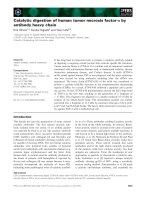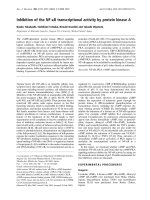Tape Reading By Linda Bradford Raschke_1 pot
Bạn đang xem bản rút gọn của tài liệu. Xem và tải ngay bản đầy đủ của tài liệu tại đây (182.63 KB, 19 trang )
August 18, 2007 Time: 11:06am chapter13.tex
Utilitarian Pricing of Annuities
•
111
Figure 13.1. First-best allocation of utilities.
while
V
∗
h
= (1 + p
h
) u
R
H
h=1
(1 + p
h
)
.
Thus, the utilitarian first best has inequality in expected utilities but may
have equality in consumption levels (Arrow, 1992).
This result is similar to Mirrlees’ (1971) optimum income tax model
where individuals differ in productivity.
2
The first best allocation pro-
vides higher (expected) utility to those with a higher capacity to produce
utility.
In the appendix to this chapter it is shown that
0 >
1 + p
n
c
∗
h
∂c
∗
h
∂p
h
> −1, (13.7)
while ∂c
∗
h
/∂p
j
0, for j = h, h, j = 1, 2, , n.
2
In Mirrlees’ model with additive utilities, the first best has all individuals with equal
consumption, and those with higher productivity, having a lower disutility for generating a
given income, are assigned to work more and hence have a lower utility.
August 18, 2007 Time: 11:06am chapter13.tex
112
•
Chapter 13
Concavity of u and (13.7) imply
∂V
∗
h
∂p
h
= u(c
∗
h
) + (1 + p
n
)u
(c
n
)
∂c
∗
h
∂p
n
> 0, (13.8)
while ∂ V
∗
h
/∂p
j
0, j = h, j = 1, 2, ,H.
3
Thus, with the given total
resources, an increase in one individual’s survival probability decreases
his or her optimum consumption, but the positive effect of higher survival
probability on expected utility dominates. The effect on the welfare
of other individuals facing only resource redistribution depends on the
shape of the social welfare function.
13.2 Competitive Annuity Market with Full Information
In a competitive market with full information on the survival proba-
bilities of individuals and a zero rate of interest, the price of a unit of
second-period consumption, c
2h
, is equal to the survival probability of
each annuitant. Individuals maximize expected utility subject to a budget
constraint
c
1h
+ p
h
c
2h
= y
h
h = 1, 2, , H, (13.9)
where y
h
is the given income of individual h. Demands for first- and
second-period consumption (annuities),
c
1h
and
c
2h
, are given by
c
1h
=
c
2h
=
c
h
= y
h
/(1 + p
h
).
The first-best allocation can be supported by a competitive annuity
market accompanied by an optimum income allocation. Equating con-
sumption levels under competition,
c
h
, to the optimum levels, c
∗
h
(p),
yields unique income levels,
y
h
= (1+ p
h
)c
∗
h
(p), that support the first-best
allocation. In particular, with an additive W, all individuals consume the
same amount:
c
∗
h
=
R
H
h=1
(1 + p
h
)
,
hence
y
h
=
1 + p
h
H
h=1
(1 + p
h
)
R.
(13.10)
3
In the extreme case when W = min[V
1
, V
2
, ,V
H
], optimum expected utilities,
V
∗
h
= (1 + p
h
)u(c
∗
h
), are equal, and hence optimum consumption, c
∗
h
, strictly decreases
with p
h
(and increases with p
j
, j = h).
August 18, 2007 Time: 11:06am chapter13.tex
Utilitarian Pricing of Annuities
•
113
13.3 Second-best Optimum Pricing of Annuities
Governments do not engage, for well-known reasons, in unconstrained
lump-sum redistributions of incomes. In contrast, most annuities
are supplied directly by government-run social security systems and
taxes/subsidies can, if so desired, be applied to the prices of annuities
offered by private pension funds. These prices can be used by govern-
ments to improve social welfare. Although deviations from actuarially
fair prices entail distortions (i.e., efficiency losses), distributional im-
provements may outweigh the costs.
4
Suppose that individual h purchases annuities at a price of q
h
.With
an income y
h
, his or her budget constraint is
c
1h
+ q
h
c
2h
= y
h
, h = 1, 2 ,H. (13.11)
Maximization of (13.2) subject to (13.11) yields demands
c
ih
=
c
ih
(q
h
, p
h
, y
h
), i = 1, 2, and h = 1, 2, ,H. Maximized expected utility,
V
h
,is
V
h
(q
h
, p
h
, y
h
) = u(
c
1h
) + p
h
u(
c
2h
).
Assume that no outside resources are available for the annuity market,
hence total subsidies/taxes must equal zero,
H
h=1
(q
h
− p
h
)
c
2h
= 0. (13.12)
Maximization of W(
V
1
,
V
2
, ,
V
H
) with respect to prices (q
1
, ,q
H
)
subject to (13.12) yields the first-order condition
∂W
∂
V
h
∂
V
h
∂q
h
+ λ
c
2h
+ (q
h
− p
h
)
∂
c
2h
dq
h
= 0, h = 1, 2, ,H,
(13.13)
where λ>0 is the shadow price of constraint (13.12). In elasticity form,
using Roy’s identity (∂
V
h
/∂q
h
=−(∂
V
h
/∂y
h
)
c
2h
), (13.13) can be written
q
h
− p
h
q
h
=
θ
h
ε
h
, (13.14)
where ε
h
=−(q
h
/
c
2h
)(∂
c
2h
/dq
h
)istheprice elasticity of second-period
consumption of individual h and
θ
h
= 1 −
1
λ
∂W
∂
V
h
∂
V
h
∂y
h
4
In practice, of course, prices do not vary individually. Rather, individuals with similar
survival probabilities are grouped into risk classes, and annuity prices and taxes/subsidies
vary across these classes.
August 18, 2007 Time: 11:06am chapter13.tex
114
•
Chapter 13
is the net social value of a marginal transfer to individual h through the
optimum pricing scheme. Equation (13.14) is a variant of the well-known
inverse elasticity optimum tax formula, which combines equity (θ
h
) and
efficiency (1/ε
h
) considerations.
The implication of (13.14) for the optimum pricing of annuities
depends on the welfare function, W, and on the joint distribution of
incomes, (y
1
, ,y
H
), and probabilities, (p
1
, , p
H
).
To obtain some concrete examples, let W be the sum of expected
utilities. Then ∂W/∂
V
h
= 1, h = 1, 2, ,H. Assume further that
V
h
= ln c
1h
+ p
h
ln c
2h
. In this case, demands are
c
1h
=
y
h
1 + p
h
,
c
2h
=
y
h
1 + p
h
p
h
q
h
, (13.15)
and
V
h
=
(
1 + p
h
)
ln
y
h
1 + p
h
+ p
h
ln
p
h
q
h
.
(13.16)
Conditions (13.14) and (13.12) now yield the solution
q
h
= φ
β
h
H
h=1
β
h
,
(13.17)
where
φ =
H
h=1
p
h
> 0 and β
h
=
p
h
y
h
1 + p
h
> 0.
Consider two special cases of (13.17):
(a) Equal incomes: (y
h
= y = R/H; h = 1, 2, ,H)
Condition (13.17) now becomes q
h
=
¯
φ
(
p
h
/(1 + p
h
)
), where
¯
φ =
H
h=1
p
h
H
h=1
p
h
1 + p
h
(>1).
(13.18)
It is seen (figure 13.2) that optimum pricing involves subsidization
(taxation) of individuals with high (low) survival probabilities.
5
5
In figure 13.2, it can be shown that
¯
φ/2 < 1.
August 18, 2007 Time: 11:06am chapter13.tex
Utilitarian Pricing of Annuities
•
115
Figure 13.2. Optimum annuity pricing in a full-information equilibrium.
(b) y
h
= y(1 + p
h
)
This, one recalls, is the first-best utilitarian income distribution, and since
all price elasticities are equal to unity, we see from (13.17), as expected,
that q
h
= p
h
; that is efficiency prices are optimal.
More generally, it is seen from (13.17) that a higher correlation
between incomes, y
h
, and survival probabilities, p
h
, decreases—and
possibly eliminates—the subsidization of high-survival individuals.
In contrast, a negative correlation between incomes and survival
probabilities (as, presumably, in the female/male case) leads to subsidies
for high- survival individuals, possibly to the commonly observed
uniform pricing rule.
August 18, 2007 Time: 11:06am chapter13.tex
Appendix
Let H = 2. The extension to H > 2 is immediate. The first-order
conditions for maximization of (13.1) subject to (13.3) are
W
1
(U
∗
1
, U
∗
2
)u
(c
∗
1
) − λ = 0,
W
2
(U
∗
1
, U
∗
2
)u
(c
∗
2
) − λ = 0,
R − (1 + p
1
)c
∗
1
− (1 + p
2
)c
∗
2
= 0, (13A.1)
where U
∗
h
= (1 + p
h
)u(c
∗
h
), h = 1, 2.
Totally differentiating (13A.1) with respect to p
1
yields
(1 + p
1
)
c
∗
1
∂c
∗
1
∂p
1
=
1
(1 + p
1
)(1 + p
2
)
( W
11
u
(c
∗
1
)
2
−W
12
u
(c
∗
1
)u
(c
∗
2
))
c
∗
1
u
(c
∗
1
)
u(c
∗
1
)
− W
12
u
(c
∗
1
)u
(c
∗
2
)
+W
22
u
(c
∗
2
)
2
+ W
2
u
(c
∗
2
)(1 + p
1
)
, (13A.2)
where (using (13A.1))
=−
(1 + p
1
)(1 + p
2
)λ
2
W
2
1
W
2
2
[ W
11
W
2
2
− 2W
12
W
1
W
2
+ W
22
W
2
1
]
−(1 + p
1
) W
2
u
(c
∗
2
) − (1 + p
2
) W
1
u
(c
∗
1
). (13A.3)
Strict quasi-concavity of W implies that >0.
Since 0 < c
∗
1
u
(c
∗
1
)/u(c
∗
1
) < 1, inserting again (13A.1) into (13A.2), we
obtain
0 >
(1 + p
∗
1
)
c
∗
1
∂c
∗
1
∂p
1
> −1, (13A.4)
as stated in the text.
August 18, 2007 Time: 11:06am chapter13.tex
Chapter 13
•
117
Differentiating (13A.1) with respect to p
2
,
(1 + p
2
)
c
∗
2
∂c
∗
1
∂p
2
=
1
(1 + p
1
)(1 + p
2
)[ W
11
u
(c
∗
1
)
2
− W
22
u
(c
∗
2
)
2
u(c
∗
2
)
c
∗
2
u
(c
∗
2
)
−W
12
u
(c
∗
1
)u(c
∗
2
) −W
12
u
(c
∗
1
)u(c
∗
2
)
u(c
∗
2
)
c
∗
2
u
(c
∗
2
)
−W
1
u
(c
∗
1
)
.
(13A.5)
The first term on the right hand side is negative, and the second is
positive, hence the sign of ∂c
∗
1
/∂p
2
cannot be established in general.
August 18, 2007 Time: 10:43am chapter12.tex
CHAPTER 12
Annuities, Longevity, and Aggregate Savings
12.1 Changes in Longevity and Aggregate Savings
In chapter 5 it was shown that when an increase in survival probabilities
is tilted toward older ages, then individuals save more during their
working years in order to support a longer retirement. Chosen retirement
ages also rise with longevity, but this was shown to compensate only
partially for the need to decrease consumption. In this chapter we shift
the emphasis from individual savings to aggregate savings.
When aggregating the response of individuals to changes in longevity,
one has to take into account that over time these changes affect the
population’s age density function (this is called the age composition effect
in contrast to the response of individuals, called the behavioral effect).
The direction of the change in this function reflects two opposite effects.
First, an increase in survival rates increases the size of all age cohorts,
particularly in older ages. Second, for given age-specific birthrates, an
increase in survival probabilities raises the population’s long-run growth
rate which, in turn, increases the relative weight of younger cohorts in the
population’s age density function. Since older ages are typically retirees
who are dissavers, while younger ages are savers, the first effect tends
to reduce aggregate savings while the second effect tends to raise their
level. We shall provide conditions that ensure that the latter effect is
dominant.
The dynamics of demographic processes generated by a change
in survival probabilities is quite complex. There exists, however, a
well-developed theory on the dependence of steady-state age density
distributions on the underlying parameters (e.g., Coale, 1972). The
analysis below builds on this theory.
The relation between life expectancy and aggregate savings has
been explored empirically in many studies (e.g., Kinugasa and Mason,
2007; Miles, 1999; Deaton and Paxson, 2000; and Lee, Mason, and
Miller, 2001). All these articles find a positive correlation between life
expectancy and aggregate savings. Since these studies have no explicit
aggregation of individuals’ response functions, they do not attempt to
identify separately the direction and size of the behavioral effect and
the age composition effect. Furthermore, it is shown below that a
August 18, 2007 Time: 10:43am chapter12.tex
98
•
Chapter 12
change in life expectancy is, in itself, inadequate to predict individu-
als’ response and hence aggregate changes. This response depends on
more specific assumptions about the age-related changes in survival
probabilities.
The existence of a competitive annuity market is crucial for individual
decisions on savings and retirement. In the absence of this market, these
decisions have to take into account the existence of unintended bequests,
that is, assets left at death because individuals do not want to outlive their
resources. Under these circumstances, an uncertain lifetime generates a
random distribution of bequests that become initial endowments of a
subsequent generation. Thus, analysis of the long-term effects of changes
in longevity has to focus on the (ergodic) evolution of the distribution
of these bequests and endowments. Section 12.6 provides an example of
such an analysis.
12.2 Longevity and Individual Savings
In chapter 4 it was shown that individuals’ optimum consumption, c
∗
, is
given by
c
∗
=−
R
∗
0
w(z)F (z,α)dz
¯
z
(12.1)
and optimum retirement age, R
∗
, is determined by the condition
u
(c
∗
)w(R
∗
) − e(R
∗
) = 0, (12.2)
where
¯
z(α) =
∞
0
F (z,α)dz is expected lifetime. A decrease in α is taken
to increase survival probabilities, ∂ F(z,α)/∂α < 0, for all z.
Recall that µ(z,α) is the proportional change in the survival function
at age z due to a small change in α:
µ(z,α) =
1
F (z,α)
∂ F(z,α)
∂α
(< 0).
Differentiating (12.1) and (12.2) totally with respect to α, it was shown
that when µ(z,α) decreases with z (equivalently, that a decrease in α
decreases the hazard rate), then dc
∗
/dα>0 and dR
∗
/dα<0.
12.3 Longevity and Aggregate Savings
Suppose that the population grows at a constant rate, g.Thesteady-
state age density function of the population, denoted h(z,α,g), is
August 18, 2007 Time: 10:43am chapter12.tex
Annuities and Aggregate Savings
•
99
given by
1
h(z,α,g) = me
−gz
F (z,α), (12.3)
where m = 1/
∞
0
e
−gz
F (z,α) dz is the birthrate.
The growth rate g, in turn, is determined by the second fundamental
equation of stable population theory:
∞
0
e
−gz
F (z,α)b(z) dz = 1, (12.4)
where b(z) is the age-specific birthrate (fertility) function.
The magnitude of g depends implicitly on the form of the survival
and fertility functions, F (z,α) and b(z), respectively. It can be determined
explicitly in some special cases. For example, with F (z,α) = e
−αz
and
b(z) = b > 0, constant, for all z ≥ 0, (12.4) yields g = b − α.The
population growth rate is equal to the difference between the birthrate
and the mortality rate.
The effect on g of a change in α can be determined by totally
differentiating (12.4):
dg
dα
=
∞
0
e
−gz
∂ F (z,α)
∂α
b(z) dz
∞
0
e
−gz
zF (z,α)b(z) dz
< 0.
(12.5)
An increase in longevity is seen to raise the steady-state growth
rate of the population. In the exponential example, substituting
(1/F )(∂ F /∂α) =−z into (12.5), we obtain dg/dα =−1.
Individual savings at age z, s
∗
(z), are
s
∗
(z) =
w(z) − c
∗
, 0 ≤ z ≤ R
∗
,
−c
∗
, R
∗
≤ z ≤∞.
(12.6)
1
Equations (12.3) and (12.4) are derived as follows (see Coale, 1972): Let the current
number of age-z females be n(z), while the total number is N. When the population grows
at a rate g, the number of females z periods ago was Ne
−gz
. If m is the birthrate, then z
periods ago mNe
−gz
females were born. Given the survival function F (z,α),
h(z,α,g) =
n(z)
N
=
Ne
−gz
mF (z,α)
N
= me
−gz
F (z,α).
Since
∞
0
h(z,α,g) dz = 1, it follows that the birthrate m is equal to m =
1
∞
0
e
−gz
F (z,α) dz . This yields equation (12.3). By definition, m =
∞
0
h(z,α,g)b(z) dz,
where b(z) is the specific fertility rate at age z. Substituting the above definition of h(z,α,g),
we obtain (12.4).
August 18, 2007 Time: 10:43am chapter12.tex
100
•
Chapter 12
Aggregate steady-state savings per capita, S, are therefore
S =
∞
0
s
∗
(z,α)h(z,α,g) dz
=
R
∗
0
w(z)h(z,α,g) dz − c
∗
from (12.6)
=
R
∗
0
w(z)
e
−gz
∞
0
e
−gz
F (z,α) dz
−
1
∞
0
F (z,α) dz
F (z,α) dz.
(12.7)
It is seen that S = 0 when g = 0. A stationary economy without
population growth has no aggregate savings per capita, corresponding
to zero personal lifetime savings. We shall now show that S > 0when
g > 0. Denote average life expectancy of the population below a certain
age, R,by
z(R). From (12.3),
z(R) =
R
0
e
−gz
zF (z,α) dz
R
0
e
−gz
F (z,α) dz. (12.8)
The average population age,
z, is
z =
z(∞) =
∞
0
e
−gz
zF (z,α) dz
∞
0
e
−gz
F (z,α) dz. (12.9)
Clearly,
z(R) <
z for any R.
Differentiating (12.7) partially with respect to g,
∂ S
∂g
=
R
∗
0
e
−gz
F (z,α) dz
∞
0
e
−gz
F (z,α) dz
(
z −
z(R
∗
)
)
> 0.
(12.10)
A positive population growth rate, g > 0, entails positive aggregate
steady-state savings.
To examine the effect of a change in α on aggregate savings, differen-
tiate (12.7) totally,
dS
dα
= w(R
∗
)h(R
∗
,α,g)
dR
∗
dα
−
dc
∗
dα
+
R
∗
0
w(z)
dh(z,α,g)
dα
dz.
(12.11)
Under the assumption that µ(z,α) decreases with z, dR
∗
/dα<0 and
dc
∗
/dα>0. Hence, when the last term in (12.11) is nonpositive, this
ensures that dS/dα<0.
August 18, 2007 Time: 10:43am chapter12.tex
Annuities and Aggregate Savings
•
101
Thesignofdh(z,α,g)/dα reflects two opposite effects: An increase in
longevity raises the survival function at all ages and, as shown above,
also raises the population growth rate. By (12.3), the first effect raises h,
while the second decreases it. Since
∞
0
dh(z,α,g)
dα
dz = 0,
(12.12)
the crucial question is which of these effects is dominant at different
ages. Since w(z) is nonincreasing in z, it can be seen from (12.12) that
the last term in (12.11) is negative when dh/dα is negative at small z
and positive at large z. The interpretation is straightforward: A rise in
longevity that raises the population steady-state density in “working
ages” when individuals save and decreases the density in “retirement
ages” when individuals dissave tends to increase aggregate savings (and
vice versa). This is the age composition effect on aggregate savings.
Two additional assumptions are made to ensure that in steady state
aggregate savings increase with longevity. First, it is assumed the age-
specific birthrate, b(z), does not increase with age:
b
(z) ≤ 0. (12.13)
Recall that z = 0 is the age when individuals plan for their future. So
this is a natural assumption, certainly at the more advanced ages.
The second assumption is that the elasticity of µ(z,α) with respect to
z does not exceed unity,
z
µ(z,α)
∂µ(z,α)
∂z
≤ 1, for all z.
2
(12.14)
This assumption deserves an explanation.
Recall that in order to determine that individuals increase their lifetime
expected savings as survival probabilities rise, it was assumed that
improvements in longevity are tilted toward older ages, ∂µ(z,α)/∂z < 0.
Taken by itself, this implies that the increase in the population’s density
function is proportionately higher at older ages. Higher longevity also
raises the population’s steady-state growth rate. As seen in (12.3), this
leads to a steeper rate of decline in the population density function with
age. The above assumption, constraining the rate of increase of survival
probabilities with age, ensures that between these two opposing effects
the latter dominates.
2
Note that the limiting case that satisfies this assumption is the exponential function,
F (z,α) = e
−αz
, 0 ≤ z ≤∞, where (z/µ)(∂µ/∂z) = 1.
August 18, 2007 Time: 10:43am chapter12.tex
102
•
Chapter 12
We can now state: Under assumptions (12.13) and (12.14), aggregate
steady-state savings rise with longevity, dS/dα<0.
The proof is in the appendix to this chapter.
Note that the assumptions underlying this result are sufficient con-
ditions, and hence a positive relation between longevity and aggregate
savings may be empirically observed even when some of these as-
sumptions are not satisfied. These assumptions are important, however,
for empirical work because they provide specific hypotheses about the
changes in survival probabilities that lead to a predictable response by
individuals, that is, to a certain direction of the behavioral effect. For
example, the common use of life expectancy as the explanatory variable
for the level of savings is clearly inadequate and may even be misleading.
12.4 Example: Exponential Survival Function
The above expressions can be solved explicitly for the particular survival
function F (z,α) = e
−αz
, z ≥ 0, a constant wage rate, w( z) = w, and a
constant age-specific birthrate, b(z) = b.
Equation (12.11) becomes
c
∗
= w(1 − e
−α R
∗
), (12.15)
and from (12.1) and (12.2),
α
R
∗
dR
∗
dα
=−
σ
σ +
R
∗
e
(R
∗
)
e(R
∗
)
e
α R
∗
− 1
α R
∗
,
(12.16)
α
c
∗
dc
∗
dα
=
α R
∗
e
α R
∗
− 1
1 +
α
R
∗
dR
∗
dα
,
(12.17)
where σ =−u
(c
∗
)c
∗
/u
(c
∗
).
Clearly,
1 ≤
α
R
∗
dR
∗
dα
≤ 0 and 0 ≤
α
c
∗
dc
∗
dα
≤ 1.
The steady-state age density function, (12.3), is
h(z,α,g) = (g + α)e
−(g+α)z
(12.18)
The population growth rate, g, with a constant birthrate, b, is solved
from (12.4), g = b − α. Hence, dg/dα =−1.
August 18, 2007 Time: 10:43am chapter12.tex
Annuities and Aggregate Savings
•
103
Aggregate steady-state savings, (12.7), are
S = e
−α R
∗
(1 − e
−gR
∗
). (12.19)
Totally differentiating (12.16),
dS
dα
=−we
−α R
∗
1 +
α
R
∗
dR
∗
dα
1 −
be
−gR
∗
α
< 0.
(12.20)
12.5 No Annuities
It was assumed that annuitization is available at all ages, which means
that individuals can take full advantage of risk pooling. To demonstrate
that this is a critical assumption, consider the case of no insurance.
3
The
budget constraint now becomes
∞
0
c(z) dz −
R
0
w(z) dz = 0. (12.21)
In the absence of insurance, there is also a constraint that assets
must be non-negative at all ages (individuals cannot die with debt).
Equating expected marginal utility across ages yields decreasing optimum
consumption whose shape reflects the individual’s degree of risk aversion.
To demonstrate that the effects of a change in longevity on savings and
retirement are, in general, indeterminate, it suffices to take particular
utility and survival functions. Thus, assume that u(c) = ln c and F (z,α) =
e
−αz
. For a constant wage w(z) = w, optimum consumption,
ˆ
c(z), now
becomes (instead of (12.1))
ˆ
c(z) = wα
ˆ
Re
−αz
. (12.22)
Accordingly, individual savings, (12.6), are now
ˆ
s(z) =
w(1 − α
ˆ
Re
−αz
), 0 ≤ z ≤
ˆ
R,
−wα
ˆ
Re
−αz
,
ˆ
R ≤ z ≤∞,
(12.23)
and optimum retirement is obtained from condition (12.2):
1
α
ˆ
R
e
α
ˆ
R
= e(
ˆ
R). (12.24)
3
Social security systems provide such annuitization. Mandatory uniform formulas may,
however, be inadequate for some individuals and excessive for others. See Sheshinski (2003,
pp. 27–54).
August 18, 2007 Time: 10:43am chapter12.tex
104
•
Chapter 12
For this condition to have a unique solution it is assumed that the left
hand side of (12.20) strictly decreases with
ˆ
R. This holds if and only if
ˆ
R < 1/α, i.e. optimum retirement age is lower than expected lifetime,
which is reasonable. When this condition holds, then d
ˆ
R/dα ≤ 0; that
is, as before, an increase in longevity leads to an increase in retirement
age.
4
Aggregate steady-state savings, (12.7), now become
S = w
1 − e
−(g+α)
ˆ
R
−
α
ˆ
R(g + α)
g + 2α
.
(12.25)
Taking into account that dg /dα =−1, it is seen that, holding
ˆ
R
constant, a decrease in α affects S positively. However, when the change
in
ˆ
R is also taken into account, the direction of the change in S is
indeterminate, depending on parameter configuration.
12.6 Unintended Bequests
The analysis in the previous section disregards the fact that in the absence
of full annuitization there are unintended bequests that affect individual
behavior and, in particular, individual savings. The empirical importance
of bequests and intergenerational transfers is debated extensively. Among
the inconclusive issues is the separation of planned bequests from those
due to lack of annuity markets. See, for example, Kotlikoff and Summers
(1981) and, recently, Kopczuk and Lupton (2005). A general equilibrium
analysis of longevity effects on aggregate savings has to take these
intergenerational transfers into account.
In the absence of full annuitization, uncertain lifetime generates a
distribution of bequests that depends on survival probabilities. A proper
comparison of steady states with and without annuitization requires
derivation of the ergodic, long-term, distribution of bequests which,
in turn, generates a distribution of individual and aggregate savings.
A general analysis of this process is beyond the scope of this book. The
issue can, however, be clarified by means of a simple example.
Suppose that individuals live one period and with probability p,
0 ≤ p ≤ 1, two periods. With no time preference, expected lifetime
utility, V, is
V = u(c) + pu(c
1
), (12.26)
4
The same condition ensures the non-negativity of assets at all ages (S
∗
(0) = w(1 −
α R
∗
) > 0).
August 18, 2007 Time: 10:43am chapter12.tex
Annuities and Aggregate Savings
•
105
where c is first-period consumption and c
1
is second-period consumption.
Without annuities and a zero interest rate, the budget constraint is
c + c
1
= w + b, (12.27)
where w>0 is income and b ≥ 0 is initial endowment. Let u(c) = ln c.
Then optimum consumption,
ˆ
c and
ˆ
c
1
,is
ˆ
c(b) =
w + b
1 + p
,
ˆ
c
1
(b) =
p(w + b)
1 + p
.
(12.28)
Having no bequest motive, individuals who live two periods leave
no bequests. Consequently, some individuals will have no initial en-
dowments. Others will have positive endowments that depend on the
history of parental survival. In fact, the steady-state distribution of initial
endowments is a renewal process.
Denote by
ˆ
b
k
the initial endowment of an individual whose k previous
generations of parents lived only one period. If p
0
is the probability
of a zero endowment, then the probability of
ˆ
b
k
is (1 − p)
k
p
0
. Since
p
0
∞
k=0
(1 − p)
k
= 1, it follows that p
0
= p. We can calculate
ˆ
b
k
from (12.27):
ˆ
b
k
= w +
ˆ
b
k−1
−
ˆ
c(
ˆ
b
k−1
) =
p
1 + p
+
p
1 + p
2
+···+
p
1 + p
k
w
= p
1 −
p
1 + p
k−1
k = 1, 2,
(12.29)
Thus, the savings of an individual with endowment
ˆ
b
k
, s(
ˆ
b
k
), are
s(
ˆ
b
k
) = w −
ˆ
c(
ˆ
b
k
) =
p
1 + p
k+1
w, (12.30)
and expected total savings, S,are
S = p
∞
k=1
s(
ˆ
b
k
)(1 − p)
k
=
p
2
1 + p
∞
k=1
p(1 − p)
1 + p
k
. (12.31)
While S > 0 for any 0 < p < 1, the sign of the effect on S of an
increase in the survival probability p is indeterminate.
Incorporating a positive birthrate would not change this conclusion:
In the absence of a competitive annuity market, the effect of increased
longevity on steady-state aggregate savings is indeterminate.
August 18, 2007 Time: 10:43am chapter12.tex
Appendix
From (12.3),
dh(z,α,g)/dα
h(z,α,g)
=
1
m
dm
dα
− h(z,α,g)z
dg
dα
+ h(z,α,g)µ( z,α).
(12A.1)
Since m = 1
∞
0
e
−gz
F (z,α) dz,
1
m
dm
dα
=
∞
0
h(z,α,g)zdz
dg
dα
−
∞
0
h(z,α,g)µ(z,α) dz (12A.2)
Substituting from (17), (12A.2) can be rewritten
1
m
dm
dα
= A
∞
0
b(z)ϕ(z,α,g) dz, (12A.3)
where
A =
∞
0
h(z,α,g)zdz
∞
0
h(z,α,g)µ(z,α)dz
∞
0
h(z,α,g)zb(z)dz
< 0
(12A.4)
and
ϕ(z,α,g) =
h(z,α,g)µ(z,α)
∞
0
h(z,α,g)µ(z,α)dz
−
h(z,α,g)z
∞
0
h(z,α,g)zdz
(12A.5)
Since
∞
0
ϕ(z,α,g) dz = 0,ϕchanges sign at least once, say at z =
˜
z.
At this point, by (12A.5),
µ(
˜
z,α)
∞
0
h(z,α,g)µ(z,α) dz
=
˜
z
∞
0
h(z,α,g)zdz
(12A.6)
Differentiating ϕ with respect to z at
˜
z,
ϕ
(
˜
z,α,g) =
∂µ(
˜
z,α)/∂z
∞
0
h(z,α,g)µ(z,α) dz
−
1
∞
0
h(z,α,g)zdz
inserting from (12A.6)
=
µ(
˜
z,α)
˜
z
∞
0
h(z,α,g)µ(z,α) dz
˜
z
µ(
˜
z,α)
∂µ(
˜
z,α)
∂z
− 1
.
(12A.7)
August 18, 2007 Time: 10:43am chapter12.tex
Annuities and Aggregate Savings
•
107
By assumption (12.14)
z
µ(
˜
z,α)
∂µ(z,α)
∂z
≤ 1
implying that
ϕ
(
˜
z,α,g) ≤ 0. (12A.8)
With strict inequality, (12A.8) implies that
˜
z is unique and that
ϕ(
˜
z,α,g) 0asz
˜
z.
(12A.9)
Since b
(z) ≤ 0, it follows from (12A.9) that
∞
0
b(z)ϕ(z,α,g) dz ≥ b(
˜
z)
∞
0
ϕ(z,α,g) dz = 0. (12A.10)
In view of (12A.3), we conclude that (1/m)(dm/dα) ≤ 0.
Since
∞
0
dh(z,α,g)
dα
dz = 0,
dh/dα is either 0 for all z or changes sign at least once, say at
ˆ
z. From
(12A.1), at
ˆ
z,
1
m
dm
dα
− h(
ˆ
z,α,g)(
ˆ
z
dg
dα
− µ(
ˆ
z,α)) = 0.
(12A.11)
Since (1/m)(dm/dα) ≤ 0, it follows that
ˆ
z
dg
dα
− µ(
ˆ
z,α) ≤ 0.
(12A.12)
Partially differentiating h(z,α,g) with respect to z at
ˆ
z gives, by
(12A.1),
∂
∂z
dh(
ˆ
z,α,g)
dα
=−h(
ˆ
z,α,g)
dg
dα
−
∂µ(
ˆ
z,α,g)
∂z
(12A.13)
From (12A.12) and the above assumption,
≥−
h(
ˆ
z,α,g)µ(
ˆ
z,α)
ˆ
z
1 −
ˆ
z
µ(
ˆ
z,α)
∂µ(
ˆ
z,α)
∂z
≥ 0.
(12A.14)
August 18, 2007 Time: 10:43am chapter12.tex
108
•
Chapter 12
Hence, unless dh/dα = 0 for all z,
ˆ
z is unique and
dh(z,α,g)
dα
0asz
ˆ
z.
(12A.15)
Since w(z) is non-increasing and
∞
0
dh(z,α,g)
dα
dz = 0,
it now follows from (A.15) that for any R
∗
,
R
∗
0
w(z)
dh(z,α,g)
dα
dz <w(
ˆ
z)
∞
0
dh(z,α,g)
dα
dz = 0.
(12A.16)
By (12.11) and (12A.16), dS/dα<0 .









